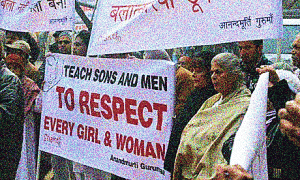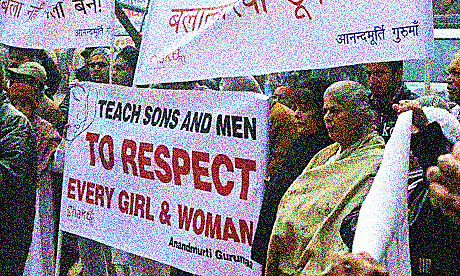The Western press has been heavily criticized for orientalizing India’s rape culture while downplaying its own.

Since the brutal rape and subsequent death of a 23-year-old physiotherapy student in mid-December ignited widespread protests throughout India and garnered the attention of international media, the topic of sexual assault has featured prominently in recent headlines. India itself has received the bulk of this attention, with reports of subsequent attacks in Kolkata, Kanpur Dehat, and New Delhi generating widely circulated commentaries and receiving constant media attention while the case of “Damini”—the fictional name for a rape victim in India—continues to unfold.
Arising cases in other countries—which ordinarily would not have generated international coverage—have also risen to prominence in the wake of the attack on Damini, such as the filmed gang rape of a 14 year-old in Romania, the rape of a 17-year-old in South Africa, and the ongoing investigation of a 16-year-old raped in Steubenville, Ohio.
The coverage of the Damini case has sparked a lively debate about how the Western media portrays rape culture abroad. The U.S. and U.K. press specifically have each received heavy criticism for their penchant to orientalize India’s rape culture and downplay—or outright ignore—the degree to which this culture features in their own societies.
Owen Jones of the Independent was one of the first to point out this hypocrisy in Western media, observing of the Damini case that “it’s comforting to think that this is someone else’s problem, a particular scandal that afflicts a supposedly backward nation.” He goes on to highlight the problematic rape cultures of both France and Britain, where in the latter, victim blaming continues to thrive: “A third of Britons believed a woman acting flirtatiously was partly or completely to blame for being raped,” he writes, citing a 2005 survey by Amnesty International. He concludes by placing the focus on a global scale, reiterating that “There is nothing inevitable about violence against women, here or anywhere.”
As another example, take an article on rape in South Africa by Andrew Harding of the BBC, rather appallingly titled, “Will South Africans ever be shocked by rape?” It relates South Africa’s rape epidemic to India’s, claiming that South Africa seems “numb—unable to muster much more than a collective shrug in the face of almost unbelievably grim statistics—seemingly far worse than India’s.”
In addition to quickly robbing South African women’s advocates of agency, this piece underscores the problems Jones addresses with relation to Western media coverage. It almost attempts to compete with the international attention on India, to highlight a place where the rape culture is even worse and to expose the failings of that particular society. “Perhaps the only certainty is that South Africa is a violent society,” he asserts, claiming that South Africans have gotten “used to” violence and that “In many communities young women talk of how they almost expect to be assaulted—and young men grow up with a dangerous sense of entitlement,” as if such attitudes manifest singularly in South Africa instead of every nation on Earth.
Harding’s article is by no means atypical. Emer O’Toole of The Guardian builds on Jones’ criticism of Western media, labeling the coverage “uncomfortably neocolonial.”
O’Toole singles out Libby Purve’s article in The Times as being a “particularly blatant example” of this neocolonialist attitude. Purve asserts early in her article that “We in the West enjoy an image of India: industrious ambition, rising economy, colour and vigour. We romanticise it, cooing at garlands and tuk-tuks in films such as The Best Exotic Marigold Hotel,” rather overtly recalling a certain book (Orientalism by Edward Said) written in the late 1970s about the West’s problematic attitudes toward “Eastern” nations. But while Purve and others seek to highlight problems elsewhere, O’Toole provides rather compelling statistics to bring the argument home:
For example, this BBC article states, as if shocking, the statistic that a woman is raped in Delhi every 14 hours. That equates to 625 a year. Yet in England and Wales, which has a population about 3.5 times that of Delhi, we find a figure for recorded rapes of women that is proportionately four times larger: 9,509. Similarly, the Wall Street Journal decries the fact that in India just over a quarter of alleged rapists are convicted; in the US only 24% of alleged rapes even result in an arrest, never mind a conviction.
Of course, O’Toole and Jones are not suggesting that India’s rape culture is less significant, or that the focus should be only on Western nations by any means. Nor are they, as Cathy Young of Newsday claims, meant to suggest that “singling out non-Western cultures for critiques of misogyny is ‘colonialist’ and ‘Othering.'” What they are suggesting is that the sensationalist headlines the Western media continues to publish about violence against women in the developing world would perhaps be more meaningful if they contributed to, instead of ignored, a dialogue on these issues at home—just as Damini’s case has been able to do for India.
Leslie Garvey is an intern at Foreign Policy in Focus.

